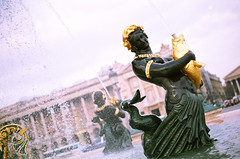Dragon--that quintessential baddie of folklore and mythology--takes center stage in this month's featured Art Print. Although Saint George is clearly the hero of Peter Paul Rubens' iconic painting, it is the pitch-black, scaly, fire-spewing beast he is attempting to slay that inspires fascination.
Dragon references first appeared in the Near East between the Fifth and Fourth Century, B.C., and have continued to this day. Nearly every culture in the world has its own dragon lore and iconography.
"Dragons are awe-inspiring patchwork creatures found in the myths and legends of cultures all around the world.... Despite their differences, many of the mythical dragons found throughout the world all began as vague serpentine ideas modeled after real creatures, beginning with a snake or some other fearsome reptile. Over time, they acquired more definite and exotic shapes as they absorbed the hopes and superstitions of the local people and borrowed the traits of local animals." (livescience.com)
Yet, not all dragons are the loathsome and feared beasts of Western and Christian mythology, in which they represent Satan, evil and the vanquishing of paganism. Many Asian cultures revere the dragon, such as in China, where dragons are symbols of power, happiness and fertility. Despite the dragon being a product of the ancient world, its image and allure are still inspiring artists today.
ABOUT THE ARTWORK
"So comes snow after fire, and even dragons have their endings."--J.R.R. Tolkien, The Hobbit.
Although many Christian saints could claim the title "Dragon Slayer," it is Saint George who gets all the glory. The Legend of Saint George and the Dragon, which originated during the Crusades, is as follows: A ferocious dragon was terrorizing a kingdom. The dragon demanded to be fed one maiden per day, or it would destroy the land with its scorching flames and putrid vapors. When all the maidens had been consumed, the only one left was the king's only daughter.
Now, as Saint George was traveling the land, he heard tell of the dragon and its hold on the people. He decided to confront the dragon and put an end to its terror. Traveling the land, he came upon the dragon's cave, where the princess was being held. The dragon rushed from its cave, where he found the knight on his steed. The two battled until George plunged his spear into the dragon, slaying it and saving the princess.
The Flemish Baroque master, Peter Paul Rubens, painted his version of the popular subject while visiting Italy. "This work was made in Ruben's youth ... and is a perfect example of the monumentality of his paintings from that period, with strong, forceful figures. Also characteristic of his work from that time are the use of directed light and very dynamic compositions, as can be seen here in the strong diagonal placement of the horse, which practically divides the canvas into two parts."
Ruben's painterly technique serves the energy of this scene, as the dragon struggles to remove the spear piercing its gaping mouth. The symbolism of the white steed rising over the black serpent could not be clearer: the victory of good over evil.
Source Citation (MLA 7th Edition)
Carroll, Colleen. "Mythology in art." Arts & Activities Apr. 2013: 19. Fine Arts and Music Collection. Web. 16 May 2013.
Document URL
http://go.galegroup.com/ps/i.do?id=GALE%7CA324397521&v=2.1&u=22054_acld&it=r&p=PPFA&sw=w
Gale Document Number: GALE|A324397521


No comments:
Post a Comment